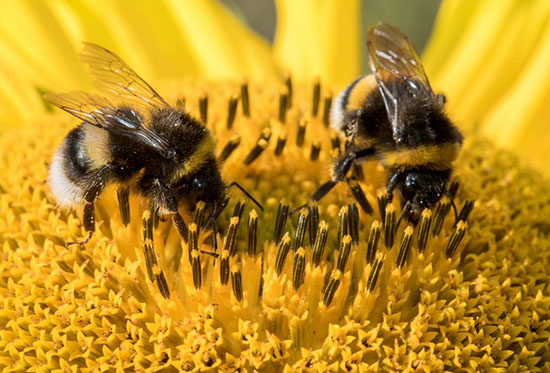有了这项技术,蜜蜂有可能替代无人机

|
大家可能听到过“拯救蜜蜂”的说法。嗯,从某个角度来说,蜜蜂如今或许正在拯救无人机。 上周二,华盛顿大学的工程师们宣布,他们设计出了“穿在”蜜蜂身上的无线平台,以解决小型无人机电池寿命短的问题。 虽然无人机已经成为未来科技的象征,但小型无人机有限的电池寿命一直是个问题,而作为自然界的飞行传粉昆虫,大黄蜂在空中停留的时间要长得多。 研究人员维克拉姆·伊耶、拉亚拉克什米·南达库马尔、安然·王、索耶·B·福勒和西亚姆纳斯·葛拉柯塔将他们的发明称为“活物联网”——即安放在活昆虫身上带有传感器和追踪器的无线飞行平台。此前该团队一直在研究另一个代号为RoboFly的昆虫飞行平台。 该平台的传感器组件带有一块微型可充电电池,最多可支持7小时的飞行。它重量很轻,只有102毫克——大约相当于7粒生大米。 伊耶是华盛顿大学电子和计算机工程系博士生。他在接受NBC News采访时说:“我们决定使用大黄蜂是因为它们够大,能携带为我们的系统供电的微型电池。” 葛拉柯塔称,这些蜜蜂每次能飞行一小时左右,而且和无人机不同,它们还能感觉到周围有什么东西。 葛拉柯塔对NBC News表示:“操控无人机时你是在到处乱飞,蜜蜂则会被特定事物吸引,比如它喜欢传粉的植物。而且除了认识环境,你还可以了解到很多跟蜜蜂行为有关的东西。” 通过几次试验,这些工程师们现在用天线来追踪蜜蜂并发出信号。这些蜜蜂总是在蜂巢附近是件好事。白天它们一直收集数据,等蜜蜂回巢时,电池就会充电,数据也会发送给研究人员。 这几位研究者认为他们设计的平台可能还有助于弄明白蜜蜂数量减少的原因。蜜蜂总数正在迅速减少,而且已经引发蜜蜂灭绝可能会威胁到食品行业的担忧。 葛拉柯塔说:“现在我们可以通过传感器来了解蜜蜂在野外的行为。也许我们能弄清楚为什么蜜蜂正走向灭绝。我们现在有了鸟瞰视角,可以观察蜜蜂体会到或感觉到的东西。” 这些工程师还承诺,他们的新时尚科技对蜜蜂来说很安全。“整个过程非常简单。我们所做的只是给它们带了个小背包,携带这个背包对这些蜜蜂来说轻而易举。它们可以飞来飞去,完全没有问题。”(财富中文网) 译者:Charlie 审校:夏林 |
You’ve probably heard the phrase “save the bees.” Well, the bees may be saving the drones—sort of. On last Tuesday, engineers at University of Washington announced that they have designed wireless platforms to be worn by bees, in an effort to solve the issue of poor battery life on smaller drones. Although drones have become a symbol of future technology, the limited battery life on small drones has been a constant issue. The bumblebee, nature’s flying pollinator, can stay in the air a lot longer. The researchers, Vikram Iyer, Rajalakshmi Nandakumar, Anran Wang, Sawyer B. Fuller, and Shyamnath Gollakota call their invention Living IoT—a flying wireless platform with sensors and trackers that rides live insects. Previously, the team had worked on another insect flight platform dubbed the RoboFly. The sensor package is a small rechargeable battery that lasts up to seven hours of flight and is light on the insect, weighing 102 mg or around the weight of seven grains of uncooked rice. “We decided to use bumblebees because they’re large enough to carry a tiny battery that can power our system,” said Iyer, a doctoral student in the UW Department of Electrical and Computer Engineering in an interview with NBC News. Gollakota said not only can the bees fly around for hour at a time, they can also sense what’s around them unlike drones. “With a drone, you’re just flying around randomly,” he said to NBC News, “while a bee is going to be drawn to specific things, like the plants it prefers to pollinate. And on top of learning about the environment, you can also learn a lot about how the bees behave.” Following multiple trials, the engineers track the bees through antennas and broadcast signals. And it does help that bees are always close to their hive. The bee collects data throughout its daily flight and as it returns to the hive, the battery recharges and researchers are sent the data. The researchers think their design could also help understand the reason behind the decline in the bee population. The population of bees is rapidly decreasing, which has led to fears that without them, our food industry could be in danger. “With the sensors, now we can understand bees’ behavior in the wild,” said Gollakota. “We can potentially understand why these bees are going extinct. Now we have a bird’s-eye view of what the bee is feeling or sensing.” The UW engineers promise the tiny creatures are safe with their new fashionable tech. “The whole process is very simple. All we are doing is just putting on a tiny backpack, and it is very easy for these bees to carry. They go and fly around and are completely fine.” |













